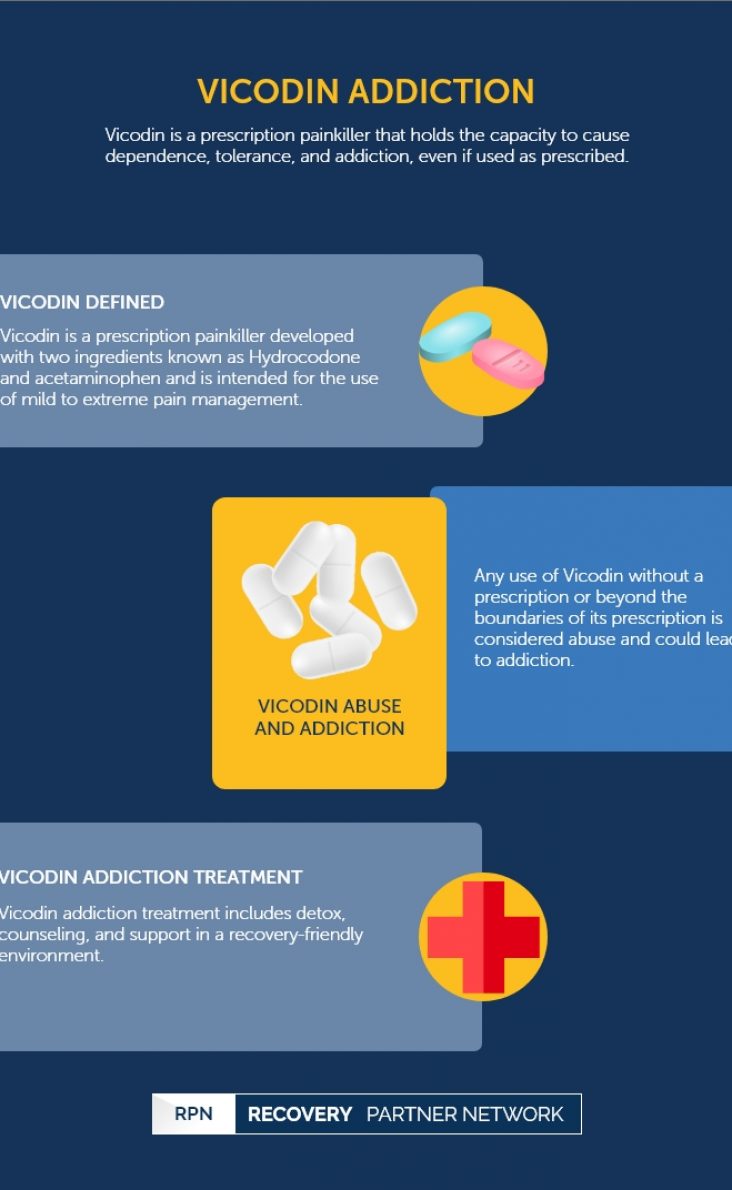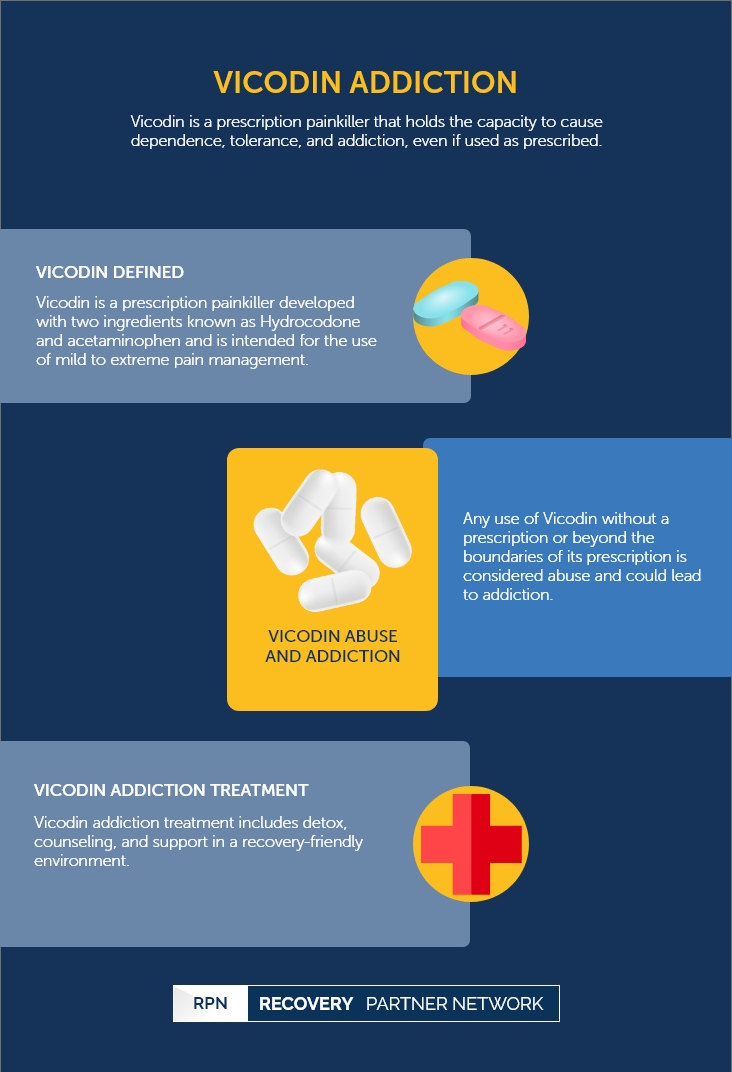Vicodin is a prescription painkiller that holds the capacity to cause dependence, tolerance, and addiction, even if used as prescribed.
Vicodin Addiction
Opioid
- Hydrocodone/paracetamol addiction
- Buprenorphine/Naloxone addiction
- Central nervous system depressant
- Codeine addiction
- Dextropropoxyphene addiction
- Fentanyl abuse
- Hydromorphone addiction
- How Long do Opioids Stay in Your System?
- Hydrocodone addiction
- Kava addiction and abuse
- Loperamide addiction
- Lortab addiction
- Medical prescription opioid
- Methadone addiction
- Morphine addiction
- Norco addiction
- NyQuil addiction
- Opioid use disorder
- OTC substance abuse
- Oxycodone addiction
- Oxycodone/paracetamol addiction
- Opioid epidemic
- Lean addiction
- Pethidine addiction
- Snorting Oxycodone
- Synthetic Opioids
- Tramadol addiction
Hydrocodone/paracetamol addiction | Table of Contents
Vicodin Defined
Vicodin is a prescription painkiller intended for the use of mild to extreme pain management. Vicodin is developed with the use of two ingredients known as Hydrocodone and acetaminophen. Hydrocodone in Vicodin is a synthetic opioid that activates the same neuroreceptors as other opiates such as heroin. Acetaminophen is the active ingredient in Tylenol.
Each Vicodin pill contains 300 mg to 325 mg of acetaminophen and three separate doses of Hydrocodone (5 mg, 7.5 mg, and 10 mg). Vicodin usually relieves pain for up to six hours, and as such, medical professionals prescribe this medication as post-surgery pain relief. This medication is usually prescribed to be taken every 4 to 6 hours.
Vicodin Abuse and Addiction
Vicodin is currently classified as a Schedule II substance under the Controlled Substance Act, after being removed from its previous position as a Schedule III drug in October 2014. This shift was caused by the high potential for Vicodin abuse and the DEA’s effort to prevent fraud and protect citizens from Vicodin abuse or misuse.
Any use of Vicodin without a prescription or the use of Vicodin beyond the boundaries of its prescription is considered abuse. One of the adverse side effects of Vicodin misuse is liver damage or dysfunction caused by the acetaminophen in the drug. Liver damage is usually caused by doses of 4,000 mg or more of acetaminophen a day. Subsequently, these findings led the FDA to issue an order to limit the use of acetaminophen in all products and stop the sales of all medications that held more than 325 mg of acetaminophen. Previous versions generally included 500 to 750 mg of acetaminophen. Individuals taking such analgesics should also be cautious of acetaminophen found in over-the-counter cold and flu drugs to avoid an overdose.
Each drug has its own set of adverse health effects, and Vicodin is no exception. The most apparent negative consequences of this drug use are the potential for addiction and liver damage. Some of the other common effects of Vicodin abuse and addiction, both mild and severe, are:
- Euphoria
- Lightheadedness
- Constipation
- Drowsiness
- Dizziness
- A relaxed and calm feeling
- Anxiety
- Aches and cramps
- Nausea and vomiting
- Depressed heart rate
- Depressed breathing rate
- Muscle pain
- Depression
FAQ
- Is Vicodin bad for you?
- How long does it take for a Vicodin to wear off?
- Does Vicodin affect the liver?
Vicodin in large doses can contribute to severe allergic reactions, liver damage, and potentially fatal overdose.
The effects of the medication last for about 4 hours. Traces of the medication can be found in the body for a number of days, and it can be detected in the hair for months.
Taking large quantities of Vicodin over a long period of time could lead to liver damage, liver failure, and even death.
Recognizing Vicodin Addiction
It can be difficult to recognize an addiction to Vicodin due to its prescriptive nature. Prolonged use or abuse of Vicodin can lead to the development of tolerance and dependence in the user. During the formation of tolerance, patients will gradually require higher and higher doses of the medication to feel its effect. During the stage of dependence, patients will rely upon the drug to function on a daily basis as their body grows accustomed to its effects. The development of tolerance and dependence is generally followed by the formation of an addiction. Patients who cease their consumption of Vicodin during this stage will inevitably experience symptoms of withdrawal.
The Diagnostic and Statistical Manual of Mental Disorders (DSM-V) helps physicians diagnose addiction and measure its severity. According to the DSM-V, patients must meet two or more of the outlined 11 criteria within 12 months to be clinically diagnosed with a substance use disorder. Patients who meet two or three of the criteria are diagnosed with a mild substance use disorder, four to five are deemed moderate, and six or more are considered severe.
The criteria are as follows:
- Taking Vicodin in larger quantities or for longer than originally prescribed or intended.
- Wishing to cut down on Vicodin use but finding it difficult.
- Investing a lot of time on purchasing, using, and recovering from Vicodin.
- Craving for Vicodin.
- Not finding enough time to fulfill work, personal or educational commitments due to Vicodin use.
- Continuing Vicodin use despite the personal and professional issues caused by its use.
- Giving up on important personal or professional commitments or activities due to Vicodin use.
- Finding oneself in dangerous situations due to Vicodin use.
- Continuing Vicodin use even if it aggravates pre-existing physical or psychological health complications.
- Forming a tolerance to the drug.
- Encountering withdrawal symptoms, which can be instantly relieved after taking Vicodin.
Vicodin Withdrawal
Since Vicodin is an opioid-based medication, withdrawal symptoms generated by this medication are comparable to morphine, heroin, methadone, or codeine withdrawal. Patients who use Vicodin for several weeks or more are highly likely to experience withdrawal symptoms, even if they follow the strict guidelines of their prescription. While symptoms may differ from patient to patient, most experience some discomfort when they try to quit or reduce their doses.
Withdrawal symptoms typically manifest around six to thirty hours after the last dose. Most patients overcome the most unpleasant symptoms within a few days or a week.
The initial stage of withdrawal may include symptoms such as:
- Cold or flu
- Stuffy or runny nose
- Headache
- Sweating
- Chills
- Nausea
- Vomiting
- Diarrhea
The severe symptoms of Vicodin withdrawal may include:
- Dilated pupils
- Goosebumps
- Nausea and vomiting
- Abdominal cramping
- Diarrhea
Vicodin Statistics
- 5.3 percent of 12th graders have reported having abused Vicodin in 2013.
- The production of prescription painkillers increased dramatically from 2000 to 2010.
- Around 131 million Americans were prescribed Vicodin, often unnecessarily, in 2011.
Vicodin Addiction Treatment
The formation of physical dependence on Vicodin is the initial stage of addiction. Vicodin withdrawals can be severe and unpleasant, and seeking medical care is the most effective way for patients to overcome their addiction to Vicodin.
Vicodin addiction treatment includes counseling and support in a recovery-friendly environment. It also offers a detox program that aids patients in managing their withdrawal symptoms safely and effectively. These programs also offer medications that help mitigate withdrawal symptoms and decrease the chances of a relapse.
Two of the most popular medications used in Vicodin addiction treatment are:
The use of Buprenorphine, in conjunction with behavioral therapy and counseling, offer a whole-patient approach to opioid addiction treatment. Buprenorphine is safe and effective when strictly taken as prescribed. This medication triggers the same receptors in the brain as Vicodin.
Also used in the treatment of alcohol use disorder, Naltrexone decreases cravings and prevents Vicodin’s effects in the event of a relapse. Naltrexone can cause a patient to no longer experience the pleasurable effects of opioids and, as a result, motivate them to discontinue their drug abuse.
Recovery Partner Network
We aim to educate and empower. If you feel our library of resources does not cover your specific need, reach out to us, and we would be happy to help.
STATISTICS
© Copyright 2025


